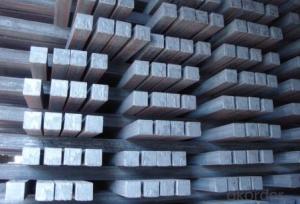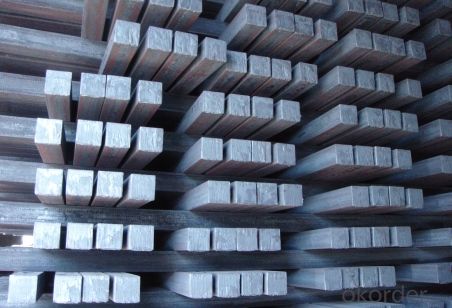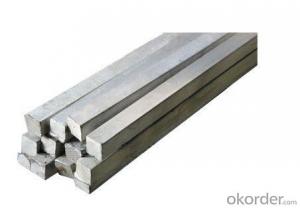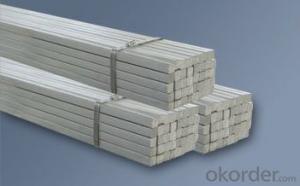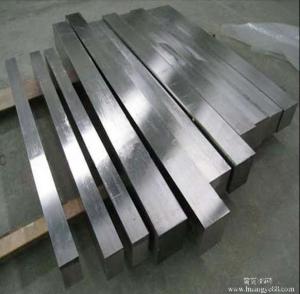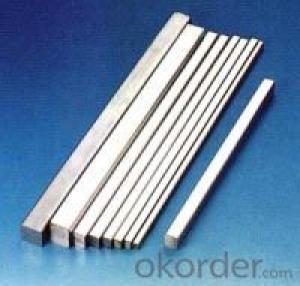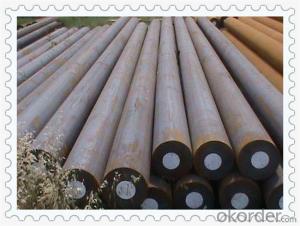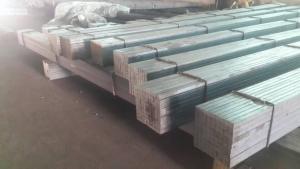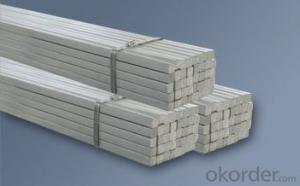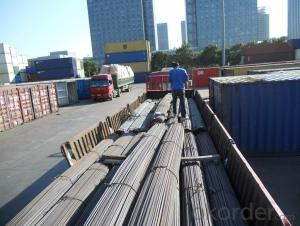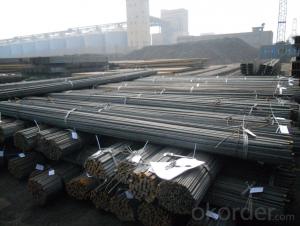Q345B High Quality Steel Square Bar
- Loading Port:
- Tianjin
- Payment Terms:
- TT OR LC
- Min Order Qty:
- 25 m.t.
- Supply Capability:
- 10000 m.t./month
OKorder Service Pledge
OKorder Financial Service
You Might Also Like
square steel billet
1.3SP, 5SP
2.terms of payment: L/C at sight
3.size: 120*120mm
4.length: 5.8~12m
square steel billet
Specifications
square steel billets
1)We procure world class quality steel billets which meets the specific requirements of the clients
The Billets produced by the company can be broadly divided into three main types i.e.
M.S. Billets
CRS Billets
Special Alloy Billets
M.S. Billets are used for rolling of TMT Re-Bars of Fe415 and Fe500 Grade and various other structural steel products.
CRS Billets are used fro rolling of CRS TMT Re-Bars.
Special Alloy Billets are used for rolling of any special grade TMT Re-Bars like Earthquake resistant TMT Re-Bars and for special grade structural steel products.
The following are the sizes of Billets available with Shyam Steel Industries Ltd.:
100 X 100
120x120
150 X 150
Physical Properties:
Description
As per IS 2830
Shyam Billets
Bend (max.) 5 mm per meter >= 5 mm per meter
Carbon (max.) 3mm per meter >= 3 mm per meter
Length 3 mt - 13 mt 3 mt - 9 mt
Chemical Properties:
Ladle Analysis:
Designation
Carbon
Manganese
C15 0.12-0.18 0.30-0.60
C18 0.15-0.21 0.30-0.60
C20 0.17-0.23 0.30-0.60
C15 MMn 0.12-0.18 0.60-1.00
C18 MMn 0.15-0.21 0.60-1.00
C20 MMn 0.17-0.23 0.60-1.00
C15 HMn 0.12-0.18 1.00-1.50
C18 HMn 0.15-0.21 1.00-1.50
C20 HMn
0.17-0.23 1.00-1.50
Billets of different designations are manufactured in three different grades namely A, B, C having sulphur, phosphorous content (on ladle analysis) and carbon equivalent as follows:
Chemical Analysis:
Grade Sulphur Phosphorous Carbon Equivalent (CE)1
Max Max Max
A 0.05 0.05 0.42
B 0.045 0.045 0.41
C 0.04 0.04 0.39
- Q: How do you use a steel square to determine angles for window trim?
- To use a steel square to determine angles for window trim, you can follow these steps: 1. Start by measuring the width and height of the window opening using a tape measure. Take note of these measurements. 2. Next, place the steel square against the corner of the window opening, aligning one edge of the square with the side of the window frame. 3. Take a pencil or marker and mark along the edge of the square where it intersects with the top and bottom of the window frame. This creates two lines on the edge of the square. 4. Now, remove the steel square from the window frame and align the marked lines on the square with the corresponding sides on the square's ruler. 5. Look for the angle measurement on the ruler where the other edge of the square intersects. This will give you the angle of the window trim that needs to be cut. 6. Transfer this angle measurement onto the window trim material by using a protractor or an adjustable angle tool to ensure accuracy. Mark the angle on the trim material. 7. Use a miter saw or a handsaw to cut the window trim along the marked angle. Make sure to cut precisely along the marked line. 8. Test the cut trim piece against the window opening to ensure a proper fit. If needed, make any necessary adjustments to the angle by recutting the trim. By using a steel square, you can accurately determine the angles for window trim, allowing for a precise fit and a professional finish.
- Q: Can a steel square be used for checking the squareness of cabinet frames?
- Yes, a steel square can be used for checking the squareness of cabinet frames. Steel squares are commonly used in carpentry and woodworking for measuring and verifying right angles. They are accurate and reliable tools for determining if cabinet frames are square and ensuring their proper alignment.
- Q: How does a steel square assist in measuring and marking angles?
- A steel square assists in measuring and marking angles by providing a straight edge and a right angle that can be used as a reference. The square has a long blade that can be placed against a surface to measure its alignment, and a shorter tongue that can be used to mark right angles. By aligning the square's blade with a desired angle or using the right angle of the square to create perpendicular lines, accurate measurements and markings can be made.
- Q: How do you use a steel square to determine roof valley angles?
- To determine roof valley angles using a steel square, you would place the square at the valley on the roof and align one edge with the roof slope. Then, you can read the angle measurement on the square to determine the valley angle.
- Q: How do you use a steel square for marking and cutting angled bridle joints?
- To use a steel square for marking and cutting angled bridle joints, follow these steps: 1. Begin by determining the desired angle for the bridle joint. This can be done by referring to the project plans or design specifications. 2. Place the steel square against the edge of the workpiece, aligning it with the edge where the bridle joint will be cut. 3. Adjust the angle of the steel square to match the desired angle for the bridle joint. Make sure the square is firmly held against the workpiece. 4. Use a pencil or a marking knife to trace along the edge of the steel square, marking the angle onto the workpiece. This line will serve as a guide for cutting the joint. 5. Once the angle is marked, use appropriate tools such as a saw or chisel to cut along the marked lines, creating the angled bridle joint. Remember to work carefully and precisely to ensure accurate cuts and a well-fitting joint.
- Q: How do you use a steel square to determine the slope of a ramp?
- To determine the slope of a ramp using a steel square, you can place the square vertically against the ramp and align it with the surface. Then, using a level, ensure that the square is perfectly vertical. Next, measure the distance from the bottom of the square to the ramp surface at the point where the square is aligned. This measurement will give you the rise of the ramp. Finally, measure the distance from the bottom of the square to the point where the ramp ends. This measurement will give you the run of the ramp. Dividing the rise by the run and multiplying it by 100 will give you the slope of the ramp as a percentage.
- Q: How do you use a steel square to measure angles?
- To use a steel square for measuring angles, you can follow these steps: 1. Ensure that the steel square is clean and free from any dirt or debris that may affect the accuracy of your measurements. 2. Identify the angle that you want to measure. The steel square typically has two arms, a longer one called the blade and a shorter one called the tongue. 3. Place the steel square on a flat surface, ensuring that the blade is aligned with one side of the angle you want to measure. 4. Rotate the square until the tongue aligns with the other side of the angle. Make sure that both arms of the square are in contact with the surface and the sides of the angle. 5. Once the steel square is properly aligned, read the angle measurement from the scale engraved on the blade or tongue. The scale usually provides measurements in degrees, with markings at regular intervals. 6. Take note of the angle measurement and record it for future reference or use. It is important to handle the steel square with care to avoid any damage that might affect the accuracy of its measurements. Regularly check and calibrate your steel square if necessary to ensure precise and reliable angle measurements.
- Q: Can a steel square be used for furniture-making projects?
- Yes, a steel square can be used for furniture-making projects. Steel squares are versatile and durable tools that can be used for measuring, marking, and checking angles in woodworking projects. They provide accurate and precise measurements, ensuring the furniture pieces are built with precision and accuracy.
- Q: Can a steel square be used for measuring the width of a wall opening?
- Yes, a steel square can be used for measuring the width of a wall opening. Its straight edges and right angles make it suitable for measuring and marking precise measurements on walls and other surfaces.
- Q: Can a steel square be used for deck railing post layout and installation?
- Yes, a steel square can be used for deck railing post layout and installation. A steel square, also known as a framing square or carpenter's square, is a versatile tool used in woodworking and construction. It has a long arm and a shorter arm, forming a right angle, which allows for precise measurements and layout. When it comes to deck railing post layout, a steel square can be used to ensure accurate placement and alignment. The long arm of the square can be used to measure and mark out the desired distance between each post, while the shorter arm can be used to create perpendicular lines for precise positioning. During installation, a steel square can also be helpful in ensuring that each post is plumb and level. By aligning the square with the post and adjusting it until it is perfectly vertical, you can be confident that your railing will be installed correctly. In summary, a steel square is a valuable tool for deck railing post layout and installation, as it provides accurate measurements, facilitates precise positioning, and helps to ensure that each post is properly aligned.
Send your message to us
Q345B High Quality Steel Square Bar
- Loading Port:
- Tianjin
- Payment Terms:
- TT OR LC
- Min Order Qty:
- 25 m.t.
- Supply Capability:
- 10000 m.t./month
OKorder Service Pledge
OKorder Financial Service
Similar products
Hot products
Hot Searches
Related keywords
